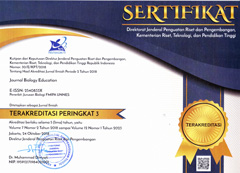PENERAPAN MODEL GUIDED NOTE TAKING DENGAN VIDEO PADA PEMBELAJARAN SISTEM SARAF DI SMP
Abstract
Penelitian ini bertujuan untuk menganalisis pengaruh penerapan model GNT dengan video terhadap hasil belajar siswa materi sistem saraf di SMP. Penelitian ini merupakan quasi experiment dengan menggunakan Pretest-Posttest Kontrol Group Design dengan 2 kelas sampel yaitu kelas IX-C (kelas kontrol) dan kelas IX-D (kelas eksperimen). Sampel diambil menggunakan non-random sampling dengan teknik purposive sampling. Hasil belajar kognitif diperoleh melalui skor Posttest dan LDS. Hasil belajar afektif diperoleh melalui angket. Data tanggapan siswa diperoleh melalui angket. Hasil belajar kognitif menunjukkan ketuntasan klasikal kelas eksperimen 86,11% dan kelas kontrol 44,44%. Hasil belajar afektif diperoleh rata-rata akhir kelas eksperimen 65,83% dan kelas kontrol 66%. Hasil tanggapan siswa terhadap pembelajaran memperoleh kriteria baik dengan rata-rata 82%. Uji hipotesis pengaruh model GNT dengan video terhadap hasil belajar siswa menggunakan uji t dan diperoleh nilai t hitung > t tabel, yaitu 4,29 > 1,99. Hal ini menunjukkan bahwa penerapan model GNT dengan video berpengaruh signifikan terhadap hasil belajar siswa..
This study aimed to analyze the influences of applying the GNT model with a video on Junior High School student learning outcomes of the nervous system material. This study was a quasi experiment using a pretest-posttest control group design with two sample classes those are class IX-C (control group) and class IX-D (experimental group). Samples were taken by non-random sampling with purposive sampling technique. Cognitive learning outcomes were obtained by posttest scores and LDS. Affective learning outcomes and Student responses data were obtained by questionnaires. The findings showed that cognitive learning outcomes satisfied the classical completeness (minimum passing grade) up to 86.11% from the experimental group and compared to 44.44% from the control group. Affective learning outcomes gained an average up to 65.83% of the experimental group and 66% of the control group both in good criteria. Student responses to learning were under good criteria with an average 82%. Hypothesis testing of the influences of the GNT model with a video on student learning outcomes, as indicated by t test, showed that the values t test > t table, namely 4.29 >1.99. This proved that applying the GNT model with a video had the significant influences to learning outcomes.
The copyright of the article once it is accepted for publication shall be assigned to the journal as the publisher. The intended copyright includes the right to publish the article in various forms (including reprints). The journal maintains the publishing rights to the published articles.
This work is licensed under a Creative Commons Attribution 4.0 International License.







